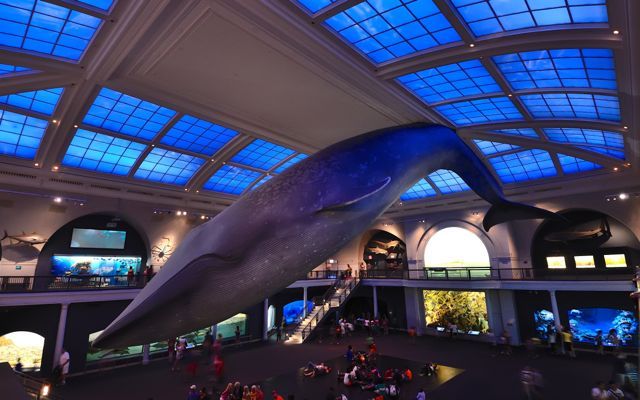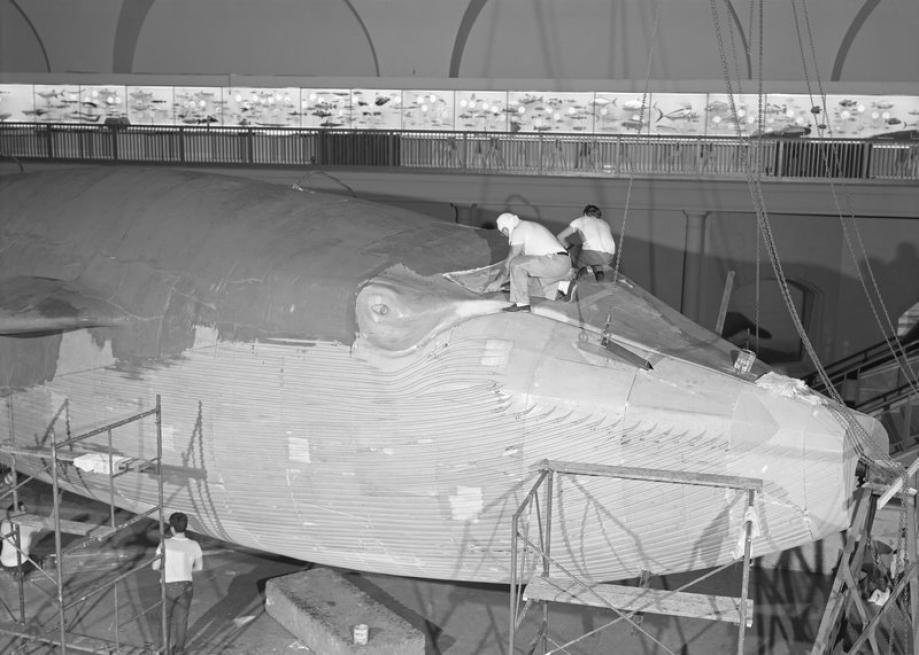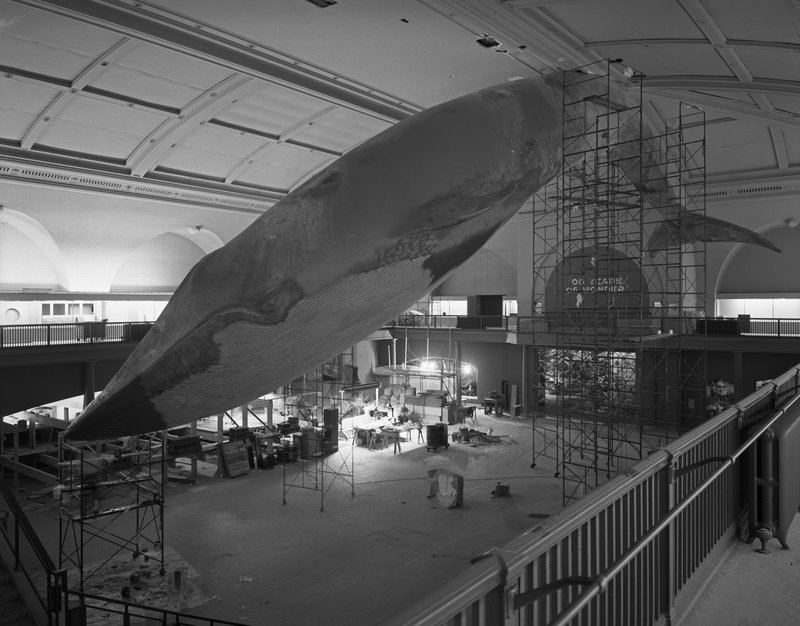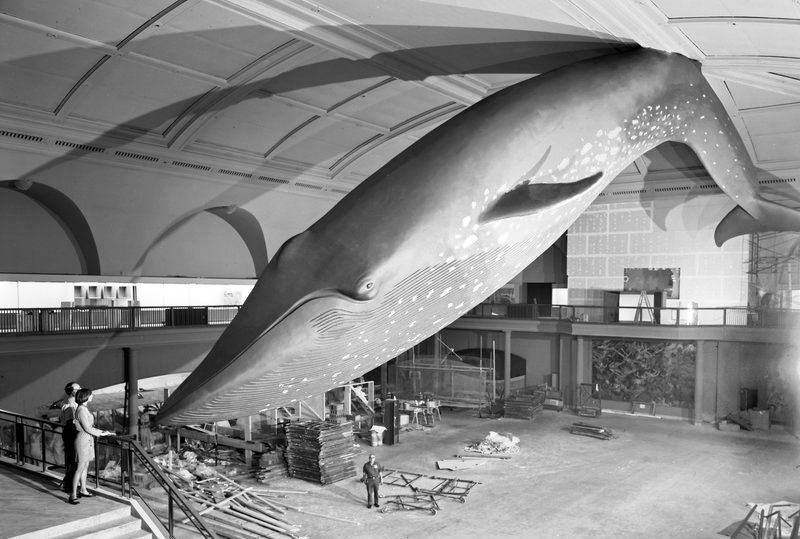A.Museum N.H. Visitors Wonder
🐳 Why Doesn’t the Whale Fall? 🐳




From right, Roman Pacheco and his cousins visiting from Ecuador, Nancy and Marco Pacheco, look up at the massive blue whale suspended from the ceiling of the Hall of Ocean Life at the American Museum of Natural History."
It is one of the biggest attractions - literally - at one of New York City’s most famous destinations: the 94-foot-long blue whale at the American Museum of Natural History. Untold numbers gaze in awe every day at the 21,000-pound creature poised majestically in midair above the Hall of Ocean Life.
They point and take photos. But how many visitors have pondered a basic question: What keeps the hulking whale “afloat”?
“I hadn’t even considered it,” said Ian Mark, 40, visiting recently from Scotland with his daughter, Sarah, 7.
“I didn’t think about it,” said Chris Witkowski, 30, from Jacksonville, Fla. “It is so massive, so that’s a good question.”

Gianina
Arana, 27, visiting from Colombia, said the room’s immersive atmosphere played a role. The false skylights are back-lit with blue bulbs and have
projectors and mirrors behind them to give the impression, when you look up past the whale, that you are looking out of the ocean at the sky. “You feel like you’re part of the ocean, and so of course the whale is there,” she said. “That’s the magic of it.”



Indeed, inside the foam and fiberglass model is an iron frame, which connects to a large cylindrical steel pipe 16 inches in diameter that extends up into the roof. To see how it is all held together requires a journey that begins in a freight elevator, leads out a locked door that is opened by remote control in a separate location, and onto what Steven Warsavage, the museum’s associate director of construction, said is actually the roof of Building 9, which houses the Hall of Biodiversity. Yes, he said, the museum feels like one entity but it is actually 26 different buildings linked together.
 On Sept. 7, 2011, a special team from the Museum's Exhibition Department vacuumed and brushed the famous blue whale model hanging in the Milstein Hall of Ocean Life.
On Sept. 7, 2011, a special team from the Museum's Exhibition Department vacuumed and brushed the famous blue whale model hanging in the Milstein Hall of Ocean Life.
A New York City icon, the 94-foot-long whale floats over the immersive hall, its walls brimming with dioramas of various ocean environments. T
he Museum's fiberglass-and-polyurethane sculpture is based on a female blue whale that was found in 1925. The model, which was first installed in 1969, received an extensive update in 2003 during the renovation of the Milstein Hall of Ocean Life. Several details-including the tapering of its tail and the bulging of its eyes-were revised or added to reflect the latest scientific information about blue whales.
At 21,000 pounds, the Museum's blue whale is the largest model of the planet's largest known animal. Though blue whales can weigh over 300,000 pounds, scientists still know remarkably little about the species because these whales spend much of their time in deep or remote waters.


The 94-foot-long blue whale is fixed to the ceiling of the American Museum of Natural History.
Credit Ruth Fremson/The New York Times
Alexandra Ortega of Queens, Ms. Arana’s cousin, guessed that “some kind of special screw” kept the whale in place. A security guard at the museum said it was powerful magnets. But the most common answer was strings or wires. (Hint: Ms. Ortega was closest to the truth.)
Credit Ruth Fremson/The New York Times
Alexandra Ortega of Queens, Ms. Arana’s cousin, guessed that “some kind of special screw” kept the whale in place. A security guard at the museum said it was powerful magnets. But the most common answer was strings or wires. (Hint: Ms. Ortega was closest to the truth.)
“Yeah, there are cables,” said Mark Manas, 62, of Merrick, Long Island, who was sitting underneath the whale with his wife, Helene, 58, and who has been coming for years.
A popular line of speculation involves either wires or cables so thin

“It’s a question I’ve asked myself, but I have no idea,” said Roman Pacheco, 31, of Manhattan, who was lying on the floor looking up at the whale, along with two cousins from Ecuador.
According to a highly unscientific survey, it seems that only 12-year-old boys really understand it. Both Andrew Schallwig of Indianapolis and Ben Heah of London had come once before when they were both 6, and Ben had wondered “what would happen if the whale fell.” But both pointed to the one spot where the whale grazes the ceiling, in the back near the fluke, and explained that there had to be steel that connected from the whale’s inner frame to the ceiling above. “It’s kind of impressive the way that lets it look free-floating,” Andrew said.

A look behind the scenes at the whale’s cylindrical structural support.
Credit
Alex J. Rota
Indeed, inside the foam and fiberglass model is an iron frame, which connects to a large cylindrical steel pipe 16 inches in diameter that extends up into the roof. To see how it is all held together requires a journey that begins in a freight elevator, leads out a locked door that is opened by remote control in a separate location, and onto what Steven Warsavage, the museum’s associate director of construction, said is actually the roof of Building 9, which houses the Hall of Biodiversity. Yes, he said, the museum feels like one entity but it is actually 26 different buildings linked together.
The Hall of Ocean Life is Building 10, built in the 1920s, with steep stairs leading to an interior with a catwalk around those false skylights. After ducking under some protruding beams and climbing over others, you reach the entrance to the room above the whale. There, Mr. Warsavage and Karen Quigley, senior director of construction and facilities, showed that the steel pipe does not do all the work alone. “Those other steel bars coming off that one connect to trusses in the room,” Ms. Quigley said. “That allows the load, the weight of the whale, to be transferred to all that other steel.”
According to Stephen Christopher Quinn’s book, “Windows on Nature” about the museum’s dioramas, Lyle Barton, the museum manager in charge of installing the whale in 1968, was so anxious that something would go wrong that he got a rod the exact distance from the whale’s chin to the floor. While the rest of the hall was being completed, he would make certain every day that the whale was holding its own.
The crew building the exhibit so resented Mr. Barton’s lack of confidence, Mr. Quinn writes, that they dribbled an imperceptible bit of glue on the rod each morning until enough layers had accumulated so that when Mr. Barton checked one day, the rod no longer fit underneath the whale’s chin. He had a moment of panic, thinking the whale was finally sinking.
The whale looks quite different now, Melanie Stiassny, the Hall of Ocean Life’s curator, said. The original was made before humans had seen blue whales in the wild. Its grayish color and bulging eyes, scientists later realized, were only due to its “being modeled on a corpse,” she said. Those and other inaccuracies were fixed when the whale was renovated in 2003; it is now bluer, and the eyes no longer bulge.
But one thing about the whale has not changed in all these years, Dr. Stiassny said: “It hasn’t budged an inch.”

Blue Whale Cleaning Time-Lapse
Click Below 👀 👇 🎥 👇 🐳
Click Below 👀 👇 🎥 👇 🐳
A New York City icon, the 94-foot-long whale floats over the immersive hall, its walls brimming with dioramas of various ocean environments. T
he Museum's fiberglass-and-polyurethane sculpture is based on a female blue whale that was found in 1925. The model, which was first installed in 1969, received an extensive update in 2003 during the renovation of the Milstein Hall of Ocean Life. Several details-including the tapering of its tail and the bulging of its eyes-were revised or added to reflect the latest scientific information about blue whales.
At 21,000 pounds, the Museum's blue whale is the largest model of the planet's largest known animal. Though blue whales can weigh over 300,000 pounds, scientists still know remarkably little about the species because these whales spend much of their time in deep or remote waters.

The Blue Whale
At 94 feet long, the 21,000-pound fiberglass model of a female blue whale is a Museum treasure. Blue whales have been hunted to near extinction. Today, the Museum's blue whale serves as a reminder of our responsibility to our environment, both on land and in the sea.
This is a model of a blue whale found in 1925 off the southern tip of South America. The largest animal alive today, this mammal species is fast, traveling up to 30 miles an hour. Blue whales are also loud, their deep sounds heard 620 miles away. They maintain their weight (sometimes more than 100 tons) on a diet of small crustaceans called krill.
Sleep Under the Blue Whale
Spend a Night at the Museum!
Spend a Night at the Museum!
Sleepovers for kids ages 6-13




AMNH Sleepovers
Be among the lucky few to spend A Night at the Museum!
A Night at the Museum, the American Museum of Natural History’s wildly popular sleepover experience, is as exciting as ever.
As the doors close and the lights dim, you and your group will head out with flashlights in search of a variety of adventures.
Meet your relatives in the Anne and Bernard Spitzer Hall of Human Origins. Climb the stairs and enter the Age of Dinosaurs, standing beneath a fearsome T. Rex. Explore our live-animal exhibitions with knowledgeable Museum explainers or encounter live animals - bats, wolves, birds of prey - and learn all about their habitats. Or perhaps discovery the Mysteries of the Unseen World now showing As the night comes to a magical close, settle down beneath the 94-foot-long blue whale, next to African elephants, or at the base of a striking volcanic formation and fall asleep in the darkened halls of one of the world’s most beloved museums.
Space is limited and dates sell out quickly. For the latest availability info, please call 212-769-5200
A Night at the Museum, the American Museum of Natural History’s wildly popular sleepover experience, is as exciting as ever.
As the doors close and the lights dim, you and your group will head out with flashlights in search of a variety of adventures.
Meet your relatives in the Anne and Bernard Spitzer Hall of Human Origins. Climb the stairs and enter the Age of Dinosaurs, standing beneath a fearsome T. Rex. Explore our live-animal exhibitions with knowledgeable Museum explainers or encounter live animals - bats, wolves, birds of prey - and learn all about their habitats. Or perhaps discovery the Mysteries of the Unseen World now showing As the night comes to a magical close, settle down beneath the 94-foot-long blue whale, next to African elephants, or at the base of a striking volcanic formation and fall asleep in the darkened halls of one of the world’s most beloved museums.
Space is limited and dates sell out quickly. For the latest availability info, please call 212-769-5200
- http://www.amnh.org/plan-your-visit/amnh-sleepovers
- http://www.amnh.org/exhibitions/permanent-exhibitions/biodiversity-and-environmental-halls/milstein-hall-of-ocean-life/the-blue-whale
- http://en.wikipedia.org/wiki/American_Museum_of_Natural_History









No comments:
Post a Comment